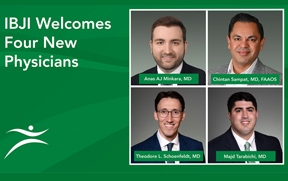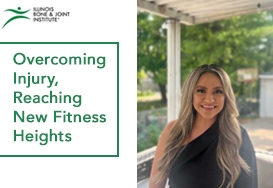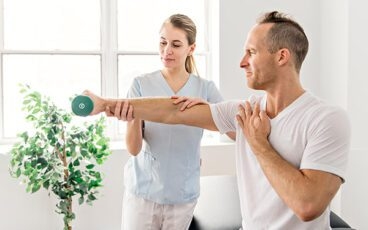Q&A with IBJI's Nicole Miller

Nicole Miller, OTR/L, CHT, CLT
Occupational Therapist
Nicole works with patients who have hand and upper extremity injuries. Her primary location is the IBJI Arlington Heights Physical Therapy and Occupational Therapy Clinic.
Continuing our celebration of National Occupational Therapy Month, we talked to IBJI Occupational Therapist Nicole Miller, OTR/L, CHT, CLT, who has been working in the field for 17 years. Read on to see what led her to this career, what she does each day, who she helps, and what you can expect from an IBJI occupational therapy session.
What Do the Credentials After Your Name Mean?
Nicole: OTR/L shows that I am a registered occupational therapist and licensed in the state of Illinois. CHT stands for certified hand therapist, and CLT is certified lymphedema therapist.
What Made You Want to Become an Occupational Therapist?
Nicole: I wanted to work in healthcare and help people. Occupational therapy is a combination of science and art. It is really rewarding work and a very flexible career.
What Kind of Education Does Your Career Require?
Nicole: I went to UW Lacrosse and my undergraduate degree was in occupational therapy. The industry has since progressed from requiring a bachelor’s degree to a master’s degree and is moving toward a doctorate. After I graduated, I ended up working in different practice areas. I have worked in schools, skilled nursing facilities, acute care, rehab, outpatient neuro therapy, lymphedema, and breast cancer rehab, but I always knew I wanted to come back to hand therapy.
What Are the Requirements to Become a Certified Hand Therapist?
Nicole: A CHT is a therapist who has a minimum of three years of clinical experience, including 4,000 hours or more in direct practice in hand therapy, and has successfully passed a comprehensive test of advanced clinical skill and theory in the upper quarter rehabilitation.
Have You Always Worked at the IBJI Arlington Heights Location?
Nicole: My current home base is Arlington Heights, but I occasionally fill in at other clinics in the northwest suburbs.
Can You Describe the OT Clinic, Your Workspace, and the Tools and Equipment You Use with Your Patients Each Day?
Nicole: We treat a variety of hand and upper extremity injuries. We have tools for working on soft tissue, range of motion, strengthening, and simulation of tasks in order to help patients to return to daily, work and leisure activities. Sometimes we do different functional exercises. For example, if someone needs to work on tying, buttoning, writing, golfing, or pickleball, we will incorporate these functional activities into therapy. Other tools we may use to help strengthen the hand and arm are theraputty, power webs, and flex bars. We also make custom splints for patients.
Can You Describe the Custom Splinting Process?
Nicole: In some of our practices, it’s a really big component. We make custom splints and braces for the upper extremity as people are recovering. This brings together science and art into the OT profession. Occupational therapists are specifically trained in custom orthosis (splint) fabrication. We will fabricate a custom splint after an orthopedic injury involving bone, joints, and soft tissue structures in order to stabilize, protect and allow for the healing of involved structures. OTs create a splint that is the most appropriate and specific for each patient and their injury. We use two different types of materials: thermoplastic and functional casting material.
About How Many Patients Do You See During a Shift?
Nicole: I see roughly 12 patients during an 8-hour shift. Our patients are usually there for 45-60 minutes at a time.
What Do You Do With a New Patient?
Nicole: First, I will gather their history. We start out with the information from the doctor’s notes, but I like to sit down to talk with the patient and get their perspective. We take measurements and assess their pain level, range of motion, and strength and learn what their functional limitations are. Then we put together an individualized treatment plan based on their needs and diagnosis. This may include splinting, manual therapy, exercise, strengthening, and functional activities.
What Type of Injuries Do Your OT Patients Have?
Nicole: I see a lot of patients with wrist, finger, and elbow fractures, carpal tunnel syndrome or other nerve-related issues, tendon lacerations, joint reconstructions, hand trauma, or any other upper extremity injury.
What’s the Most Gratifying Part of Your Job?
Nicole: First, I like helping people get better! Second, I really enjoy the interaction. I get to meet so many different people.
Is Your Success Based on Your Individual Contribution or a Team Approach to Care?
Nicole: It’s a team approach to care and this is where IBJI really shines. The reason I like working at IBJI is that we have great collaboration and communication between therapists and physicians. The patient is an integral part of that team. This collaborative care model improves the patient’s outcome efficiently.
Want to Know More About OT Services at IBJI?
We are here for you to help you move better and live better. Get details about our occupational therapy services, locations, and team.
*Note: Most, but not all clinics have an occupational therapist on staff.




